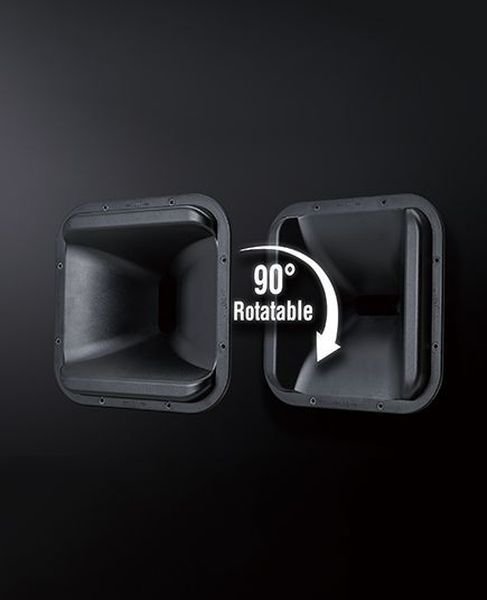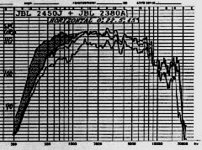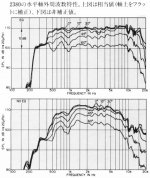GedLee Thank You,
I found your Lazy Susan and measurement information on your web site and on DIYaudio. Funny thing when I googled Lazy Susan my sister‘s name popped up.
Some of the building trades stuff that I teach I will share here: Cut a 28 inch diameter disk out plywood or MDF, which is 90 inches in circumference, tack one of these
Amazon.com: Singer 81603 Vinyl Tape Measure, 96"
around the ~ 28 inch diameter disk and each ¼ inch equals one degree. 28 inch diameter seems to be a good size for big speakers.
Thanks DT
I found your Lazy Susan and measurement information on your web site and on DIYaudio. Funny thing when I googled Lazy Susan my sister‘s name popped up.
Some of the building trades stuff that I teach I will share here: Cut a 28 inch diameter disk out plywood or MDF, which is 90 inches in circumference, tack one of these
Amazon.com: Singer 81603 Vinyl Tape Measure, 96"
around the ~ 28 inch diameter disk and each ¼ inch equals one degree. 28 inch diameter seems to be a good size for big speakers.
Thanks DT
So you still don't see how the math predicts a wider response?😕
Not yet, no.
I still don't see a direct comparison of the response with and without WG to show the response widens.
Or a broad explanation of how this occurs.
It may be that I don't follow because I don't think of it the way you do, so your explanations just don't resonate with me.
If anyone else finds it clear and obvious then please jump in.
The first test that I ever did...used a Panasonic 1" flat honeycomb piston tweeter...A perfectly flat source. The polar response was pulled out.
That is a persuasive data point, I wish you had mentioned it earlier.
Can you show the polars?
[should be]...a flat source at their outlet so I doubt that your explanation...
Well, they are compromised by practical issues like ease to manufacture, of course.
For instance the classic JBL compression drivers weren't optimal for a flat source, the later drivers improved this but didn't discuss it much, presumably to gloss over that there ever had been a problem.
Whereas the Altecs were compromised by the need to avoid earlier patents, or so I read.
ξ is the modified radial dimension equal to the sum of the distances to each foci divided by d the foci separation. On axis it will just be the distance down the device.
I expected ξ = d sinh μ - how does your choice work?
In your book, p.137 in eqn. 6.4.10 shouldn't c²η² be c²ξ² ?
Best wishes
David
Sorry, no. It seems to me that if some of the energy follows other modes then this solution could have been found from a less direct method. However, I believe this solution is the best practical option and go from there.It may be that I don't follow because I don't think of it the way you do, so your explanations just don't resonate with me.
If anyone else finds it clear and obvious then please jump in.
On the ocean till after New year. Be back then.
Want to check eqn. 6.4.10 before you leave?
Not only does the c²η² term look incorrect (typo?) but the form also.
It is formally identical to 6.4.9 (clearer if multiplied by -1).
It should be very similar but I don't expect it to be identical, unless there is some trick with the variable substitution that is not explained.
Best wishes
David
GedLee Thank You,
I found your Lazy Susan and measurement information on your web site and on DIYaudio. Funny thing when I googled Lazy Susan my sister‘s name popped up.
Some of the building trades stuff that I teach I will share here: Cut a 28 inch diameter disk out plywood or MDF, which is 90 inches in circumference, tack one of these
Amazon.com: Singer 81603 Vinyl Tape Measure, 96"
around the ~ 28 inch diameter disk and each ¼ inch equals one degree. 28 inch diameter seems to be a good size for big speakers.
Thanks DT
Just a quick check of your math, the circumference of a 28 inch diameter disk is 87.9645928 inches.
If you need 90 inches circumference, then the disk should be 28.647" diameter.
I drew out a 28" diameter circle in SketchUp, and 1 degree according to the protractor is indeed 1/4" as measured with the virtual tape measure.
DualTriode, thanks for the tip.
DualTriode, thanks for the tip.
Just a quick check of your math, the circumference of a 28 inch diameter disk is 87.9645928 inches.
If you need 90 inches circumference, then the disk should be 28.647" diameter.
Please do the math if you build this thing.
I said 90 inches in circumference, 90 inches is the critical dimension. As I indicated, ~ 28 is a approximate number, not too much in error.
Just For Fun DT
Last edited:
Hello,
If I were developing a model of an acoustic impedance transformer I would start at the limits. At one end of the scale is the piston at the end of a pipe propagating into the listening room. At the other end of the scale is a piston propagating into the listening room on a very large flat baffle. Between these limits we can conceive of any shape horn / waveguide; short and shallow to long and slowly expanding, or any other shape in between.
From throat to mouth we can cut a section through this horn /waveguide acoustic impedance transformer. Starting at the throat, or higher impedance end of the horn / waveguide we can adjust the throat diameter and flare to control the directivity as we choose. One thing to keep in mind is that as we increase the throat diameter the throat impedance decreases, it is a tradeoff. The impedance differential between throat and mouth allows us to shape the directivity of the horn / waveguide. A larger diameter throat reduces the throat impedance and the ability to control directivity.
In terms of math or formulas, look for throat diameter or throat radius in the denominator. The smaller the throat radius means greater throat impedance and greater ability to control directivity.
Thank You DT
If I were developing a model of an acoustic impedance transformer I would start at the limits. At one end of the scale is the piston at the end of a pipe propagating into the listening room. At the other end of the scale is a piston propagating into the listening room on a very large flat baffle. Between these limits we can conceive of any shape horn / waveguide; short and shallow to long and slowly expanding, or any other shape in between.
From throat to mouth we can cut a section through this horn /waveguide acoustic impedance transformer. Starting at the throat, or higher impedance end of the horn / waveguide we can adjust the throat diameter and flare to control the directivity as we choose. One thing to keep in mind is that as we increase the throat diameter the throat impedance decreases, it is a tradeoff. The impedance differential between throat and mouth allows us to shape the directivity of the horn / waveguide. A larger diameter throat reduces the throat impedance and the ability to control directivity.
In terms of math or formulas, look for throat diameter or throat radius in the denominator. The smaller the throat radius means greater throat impedance and greater ability to control directivity.
Thank You DT
ξ is the modified radial dimension equal to the sum of the distances to each foci divided by d the foci separation. On axis it will just be the distance down the device.
I expected ξ = d sinh μ - how does your choice work?
I had time to think about this, in Earl's absence.
His ξ is, in fact, what I expected, just expressed verbally.
One less question for Earl when he is back, and revision for me of hyperbolic functions.
David
But reread Freehafer and found he says "Radiation of shorter wavelength than the radius of the throat is not appreciably diffracted"
So still this question still remains.
Last edited:
I am not sure what Freehafer means in his statement - that a waveguide will not diffract any more than a rigid disk of the same size, or that as the frequency goes up there is less diffraction. The second is quite true, but the first contradicts experimental evidence.
So the question might still remain in your mind, but the evidence all clearly supports my contention and none contradicts it.
So the question might still remain in your mind, but the evidence all clearly supports my contention and none contradicts it.
I am not sure what Freehafer means in his statement
It's on p. 3 of his thesis, in the link I provided earlier in post #190.
...but the evidence all clearly supports my contention and none contradicts it.
The problem is that I haven't seen any of this evidence.
You said it is clear from a comparison of a compression driver with and without an OS WG.
I asked to see such a comparison and you said, in post #157
No I don't. I don't need to prove the theory to myself.
Then you mentioned a similar test with a flat tweeter.
In post #282 I asked to see those polars but never received a reply.
If you don't have the data anymore than such is life, this is a voluntary forum, after all.
But I would like to see some evidence, not to be difficult but because I actually hope your statement is true, it will make better speakers possible.
I should be able to solve this with BEM pretty soon, should be educational.
Best wishes
David
awful quiet...
I am at work on BEM simulations, to compare OS with no horn - as a start.
A lot of work to understand the software and set it all up correctly.
Also a lot of details to make sure the results are valid and not corrupted by numerical issues of finite precision, sensitivity to how the problem is reduced to discrete elements and so on.
I didn't like Numerical Analysis at university, I should have paid more attention.
Best wishes
David
Last edited:
I got interested in this after I acquired some of their old, long snout drivers:
Vol.1, No.21 - JBL’s New Optimized Aperture Horns and Low Distortion Drivers
"When the JBL 375 compression driver was designed during the fifties, it was based on the exit geometry of the original Western Electric 594 driver.
Subsequent variations, such as the JBL 2441, 2445, and 2450 family all maintained the original exit geometry and were designed to work with four decades of horn hardware with 50 mm (2 in) throat diameter."
...which means my 2445 drivers (made in the 80's) were updated copies of a 1930's driver. Their slowly flaring exit geometry is a great match for the big old Western Electric horns, or the Inlow horn (which is 90cm long) - and not a great match for most modern (short) horns.
Thus, the "four decades of horn hardware" bit is interesting:
The JBL 375 was originally mated to an adapter + fairly big radial horn (2350). Their combined depth was about 60cm. OK.
By the 80's, JBL was mating these drivers with much shorter horns, like the 2380 (only 23cm deep). That's a big mismatch between the flare rate built into the driver's snout, and the flare rate of the horn.
That's why some Japanese added an throat extension to the 2380A.
The effects are visible in the shaded part of the response curve below.
In the second plot, EQ-ed response shown compared to the raw response (below).
With DSP the response could be improved.
The 2380A isn't a bad horn, provided it's implemented properly.
Attachments
Last edited:
The entry angle of the 2380A is actually wider than one might expect (ca. 25°), therefore they go well with many pancake compression drivers.
This raises the question: what's worse, a severe throat angle mismatch, i.e. 0° angle exit connected to a >20° throat entrance,
versus a better exit-throat connection with a diffraction slot at the end of the throat section?
What if compression ratio is also taken into consideration (vintage versus modern drivers)?
This raises the question: what's worse, a severe throat angle mismatch, i.e. 0° angle exit connected to a >20° throat entrance,
versus a better exit-throat connection with a diffraction slot at the end of the throat section?
What if compression ratio is also taken into consideration (vintage versus modern drivers)?
Last edited:
That's why some Japanese added an throat extension to the 2380A.
The effects are visible in the shaded part of the response curve below.
In the second plot, EQ-ed response shown compared to the raw response (below).
With DSP the response could be improved.
The 2380A isn't a bad horn, provided it's implemented properly.
Thanks for that info. I did a home brew throat extension (on a equivalent but cheaper ebay horn), and got a vaguely similar result. I don't know if I kept a plot of the difference: I just thought of it as giving 100Hz more low end. The whole point to using big horn drivers is their better LF extension, so that's a win.
I sold the JBLs about a month ago, so I can't re-check.
The Yamaha DSR-112 has been a great standard setting box. It's been the most often recommended <$1000 speaker on live-sound forums for at least a half-dozen years.
There's a recently introduced DZR line that will probably phase out the DSR, but not many reviews yet, and currently $2-300 higher. It touts more and better linear-phase FIR tuning, as does nearly every new pro-sound box on the market. The DSR-112, which is already a very good buy, may become a hell of a great buy when Yamaha promotes the phaseout.
This is the waveguide, or should I say: horn, used in the Yamaha DZR series:

- Home
- Loudspeakers
- Multi-Way
- 1.4" or 2" throat large constant directivity horns you can actually buy!

